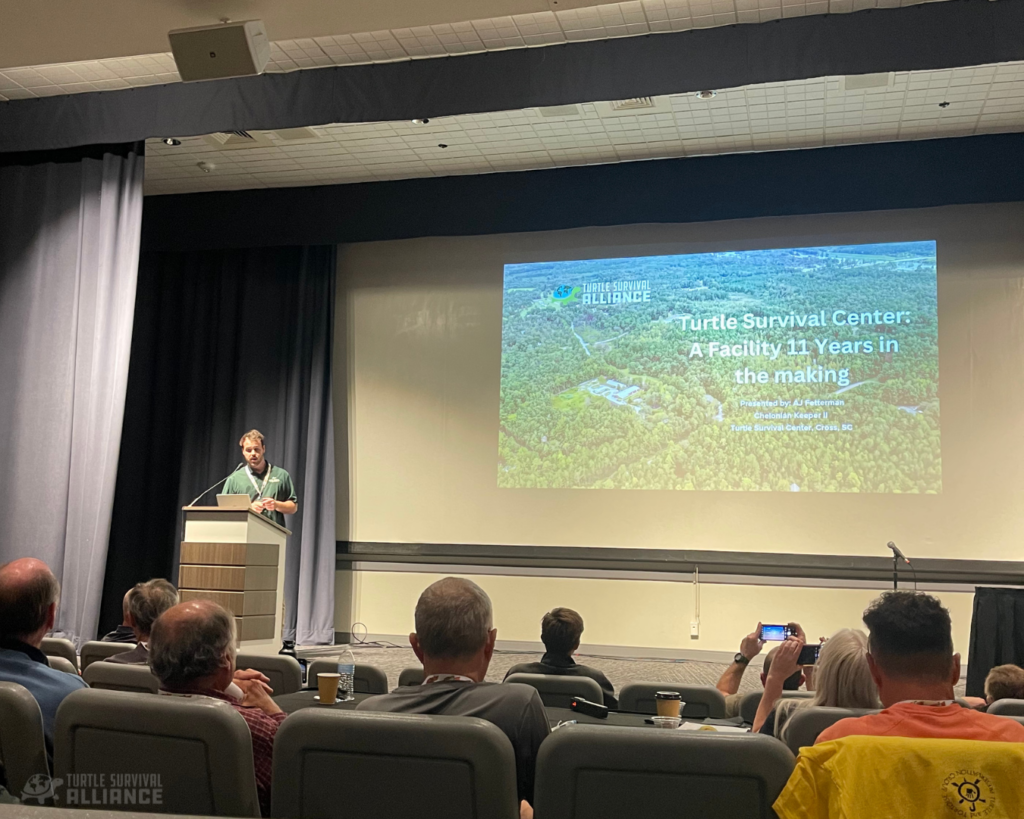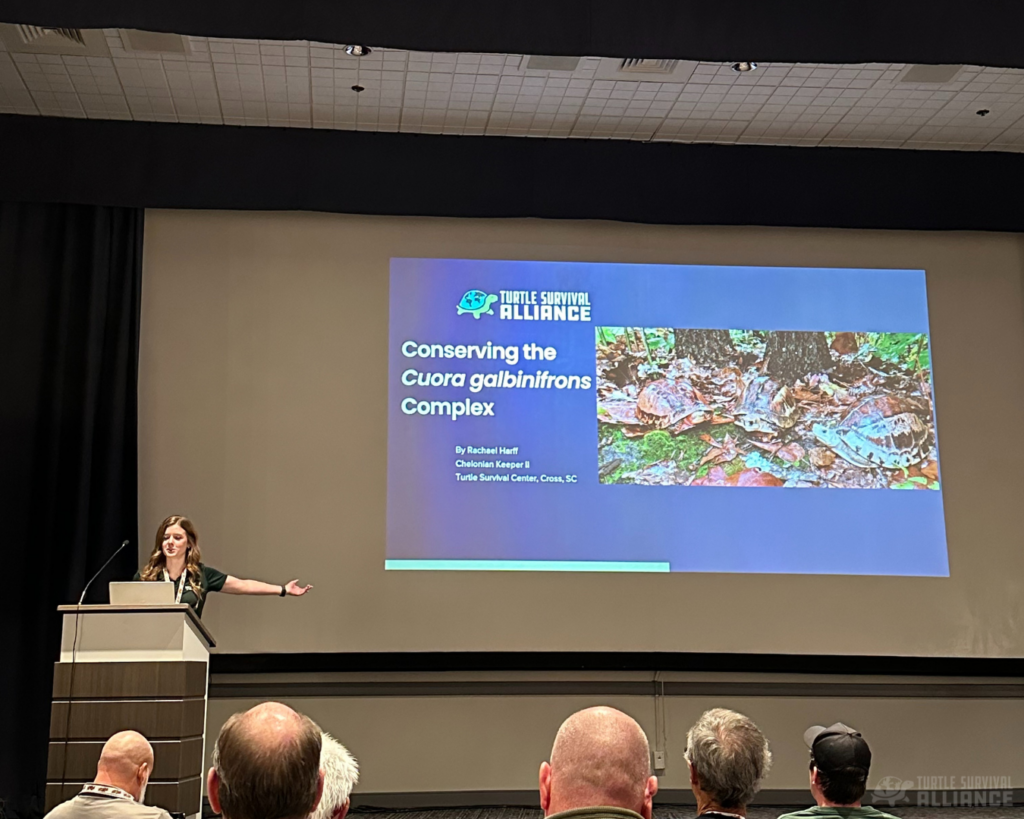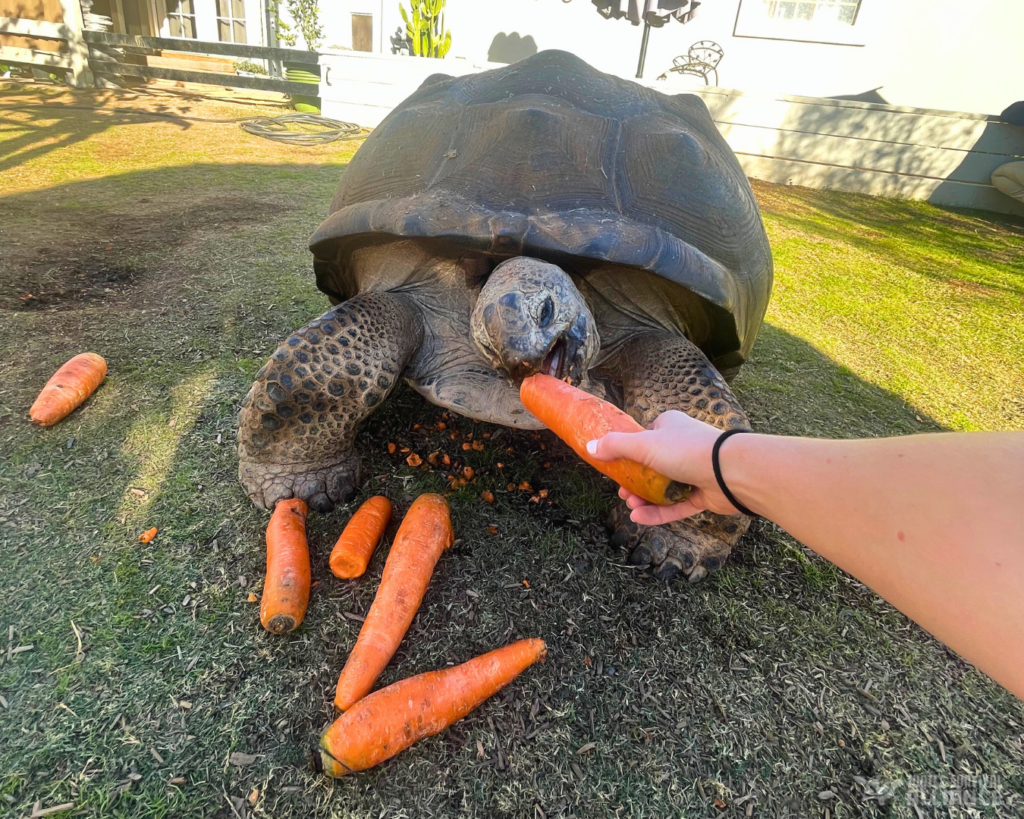Tails from the Turtle Survival Center: An Eventful Winter
By A.J. Fetterman, Chelonian Keeper II and Engagement Coordinator
It has been a very exciting winter so far here at the Turtle Survival Center (TSC). This past November, I headed to Mesa, Arizona, with my fellow Chelonian Keepers, Rachael and Nita, to attend the Conference on Captive Care and Breeding of Turtles and Tortoises hosted by the Turtle & Tortoise Preservation Group. We were fortunate enough to be asked to give presentations about some of the things that we do at the Center and some of the experiences that we have had in our time working in chelonian husbandry. I gave a presentation about how some of our turtle housing spaces are designed to make them as functional and time-effective as possible. One example of this is plumbing all of our enclosures to have connections directly to a water source as well as a drain for dirty water, making daily maintenance much quicker. Clean, fresh water is a must for the turtles in our care, and this makes achieving that much easier.


AJ Fetterman (left) and Rachael Harff (right), Chelonian Keepers at the Turtle Survival Center (TSC), both gave presentations at the Conference on Captive Care and Breeding of Turtles and Tortoises in November, 2024. Photos by Katie Swartz
The Center strives to be best in class when it comes to chelonian care, so we were happy to share some of our methods with this audience of turtle and tortoise caregivers and enthusiasts. I also learned a lot from the many other experienced presenters who come from zoos and turtle facilities similar to the Center, as well as private collectors of turtles and tortoises. We look forward to attending this conference in the future so that we can continue to collect and share knowledge on chelonian care. Turtle Survival Alliance’s long-term goal to create large assurance colonies throughout the United States cannot be done alone, so these partnerships are important to achieving our vision of zero turtle extinctions.

While attending the conference, the keepers also got to visit the Arizona Tortoise Compound and meet some of their turtles, including this Aldabra Giant Tortoise (Aldabrachelys gigantea). Photo by Rachael Harff
Later on in the winter, Cross, South Carolina, saw its first snowfall in seven years. Not only did it snow, but it accumulated to around three inches and left us under a white blanket for three days. We house many species of turtle outside, and all except for our Bourret’s Box Turtles (Cuora bourreti) are able to stay outside throughout the winter, even through snowfall. The southeastern United States was chosen to establish our Turtle Survival Center for a few reasons, but primarily because of its similar climate to that of southeastern Asia, where many of our inhabitants come from. This includes the occasional freezing temperatures and snowfall for many of the species, especially the mountain-stream dwelling species from China, like our Pan’s Box Turtles (Cuora pani) and Chinese Big Headed Turtles (Platysternon megacephalum).
Turtles are reptiles, which makes them cold-blooded. This means that they need to absorb heat from their environments, and don’t produce any themselves, like warm blooded mammals and birds. Typically, when temperatures drop, this means that turtles will shut down and brumate, a type of hibernation in reptiles. Throughout the winter months, we don’t need to feed most of the outdoor turtles because their metabolism slows down so much that they have no interest in eating. They will tuck down under a blanket of leaf litter or burrow into the soil and wait for warmer months to return. Before and after the most recent storm, we located each turtle, did a quick health assessment, and tucked them in under a dense pile of leaves. More aquatic species of turtle will be a little more active during the winter, and we even saw some turtles moving during the snowfall, like the Beale’s Eyed Turtle that was found walking around through heavy snow.
We spotted this Beale’s eyed turtle (Sacalia bealei) trudging through the snow during our evening safety checks at the TSC. This highly aquatic species originates from China, and like in the subtropical climate of the South Carolina Lowcountry, can experience very cold temperatures in its native range, so it fares just fine in the snow. Video by Clinton Doak
It looks like we will have a colder-than-typical winter, but fortunately, a harsh South Carolina winter is still very manageable for the species that we work with. This all makes the impending spring exciting, and we are excited for the brumating turtles to emerge and become active, even if that means a lot more work for us keepers. But more on that next time!

-A.J.
Header image: From left: Rachael Harff, Nita Yawn, and A.J. Fetterman, Chelonian Keepers at the TSC, in Mesa, Arizona, for the Conference on Captive Care and Breeding of Turtles and Tortoises. Photo by Katie Swartz
